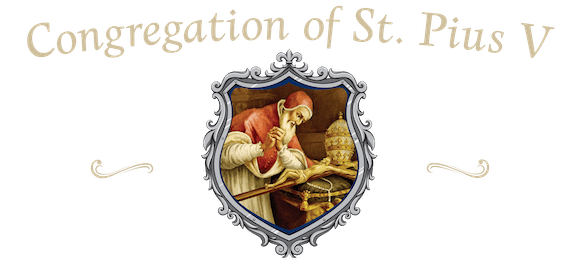Steps to the Priesthood
Tonsure
Tonsure is a sacred rite by which a layman becomes a member of the clergy. By this step, a young man renounces the world in order to give undivided attention to the service of God. A cleric may handle sacred vessels, such as the chalice, the ciborium, and the monstrance, to clean them or prepare them for use. Tonsure is derived from the Latin tonsura, signifying the cutting of the hair. Since it was the custom for Roman slaves to have their heads shaved, a cleric is tonsured to proclaim himself a slave of Christ.
Scissors Used for Tonsure


Porter
The office of porter is the first of the minor orders. In ancient times it was the duty of the porter to lock and unlock the doors of the church, to summon the faithful to Mass by ringing the bell, and to ensure that the people maintained proper decorum within the church. During the ceremony, the porter is given the key to the church door. He then locks and unlocks the door and rings the church bell.
Presented to the Porter during the ceremony Ringing the Bell

Porter's Key


Lector
The lector, or reader, is ordained to read the Holy Scriptures aloud in the church. He also instructs children in the faith. In the early Church, lectors, who had charge of the Sacred Scriptures, often suffered severe persecution for refusing to surrender the holy books. During the ceremony, the bishop places the Bible or altar missal in the hands of the lector.


Exorcist
The exorcist is ordained to impose hands on those possessed by evil spirits, while reciting the Church’s prayers to free them from the power of the devil. In the wisdom of Holy Mother Church, priests alone exercise this power now, and only by special commission of the bishop. When conferring this minor order, the bishop places the Book of Exorcisms in the hands of the exorcist.
Roman Ritual for the Exorcist

Acolyte
The word acolyte is from the Greek, meaning “one who follows, assists, or accompanies.” An acolyte is ordained to assist the subdeacon during a Solemn High Mass. In the first few centuries of the Church, one of the acolyte’s functions was to carry letters concerning ceremonies between different churches. As pagans sought every opportunity to profane the Christian mysteries, this office was one of great trust. During the ceremony, the bishop places the cruets and a candlestick and candle in the hands of the new acolyte.




Subdeacon
The subdiaconate is the first degree of major orders. The subdeacon prepares the hosts, wine, and sacred vessels for the Holy Sacrifice of the Mass. He is permitted to chant the Epistle and to wash the sacred linens which have been used at the altar. A subdeacon is bound to perpetual celibacy and to the daily recitation of the Divine Office. During the ordination, the subdeacon places his hand on a chalice and paten. He is vested by the bishop in an amice, a maniple, and the tunic, and he receives the Book of Epistles.






Deacon
When ordained to the diaconate, a deacon receives an indelible mark on his soul. The word deacon means “minister” or “servant.” Thus, he assists the priest during Holy Mass. He may chant the Gospel, preach, and expose the Blessed Sacrament during Benediction. With special permission, the deacon may also administer Baptism and Holy Communion.
During the diaconate, the bishop imposes one hand on the head of the deacon-elect. He is vested with a stole worn over the left shoulder and with the dalmatic. The deacon also places his hand on the Book of Gospels.




Priest
A priest has the power to offer the Holy Sacrifice of the Mass, during which he consecrates the bread and wine into the Body and Blood of Our Lord. He has the power to absolve sins in the Sacrament of Penance and to administer Baptism and Extreme Unction. Priests may also bless persons and objects. At an ordination the bishop imposes both hands on the head of the priest-elect. He also anoints the hands of the priest with sacred chrism. Once ordained, the new priest celebrates the ordination Mass with the ordaining bishop.
The manutergium, or “binding cloth,” is used to bind the consecrated hands of a newly-ordained priest during the rite of ordination in order to prevent the holy oil from dripping off his hands. For centuries it has been a custom to present the manutergium to the priest’s mother. She then keeps it and is buried with it wrapped around her hands. According to a pious tradition, when she goes before Our Lord for judgment, He will say to her: “I have given you life. What have you given to me?” She will be able to hand Him the manutergium and respond, “I have given you my son, a priest.” At this, Our Lord will grant her entry into paradise.








Manutergium
The Holy Sacrifice of the Mass







